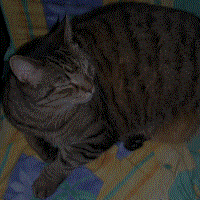Steganography
Steganography is the practice of concealing a file, message, image, or video within another file, message, image, or video. The word steganography combines the Greek words steganos, meaning "covered, concealed, or protected", and graphein meaning "writing". Unlike cryptography, which obscures the content of a message, steganography aims to hide the very existence of the message. This technique can be used for a variety of purposes, including confidential communication and secret data storage.
History[edit | edit source]
The use of steganography dates back to ancient times. One of the earliest recorded uses of steganography is described by Herodotus, who tells the story of a message tattooed on a slave's shaved head and hidden under regrown hair. In the Renaissance, Giambattista della Porta described using invisible ink made from lemon juice to write secret messages. Throughout history, various methods have been developed for hiding information, including the use of microdots, invisible inks, and covert channels in computer networks.
Techniques[edit | edit source]
Steganography techniques vary widely and can be categorized into physical and digital methods.
Physical Steganography[edit | edit source]
Physical steganography includes historical methods such as writing in invisible ink or hiding a message in an unsuspecting object or within another document. Other examples include the use of microdots and the null cipher, where plaintext is hidden within a larger, innocuous text.
Digital Steganography[edit | edit source]
Digital steganography involves the concealment of information within digital media. The most common forms of digital steganography include:
- Image Steganography: Hiding information within the pixels of an image. Techniques such as least significant bit (LSB) insertion modify the least important bits of the pixel values to encode information.
- Audio Steganography: Concealing messages within audio files, which can involve modifying the least significant bits of audio samples or using phase coding to hide information.
- Video Steganography: Similar to image and audio steganography but applied to video frames. Techniques may involve LSB, discrete cosine transform (DCT), and motion vector techniques.
- Text Steganography: Hiding information within text by manipulating spaces, using synonyms, or altering the text formatting in a way that is not apparent to the casual observer.
Applications[edit | edit source]
Steganography has both legitimate and illegitimate applications. It can be used for protecting intellectual property, securing confidential information, and ensuring privacy in communications. In digital rights management (DRM), steganography can help in tracking and managing copyright and distribution of digital media. However, it can also be used for malicious purposes, such as hiding malware or facilitating unauthorized data exfiltration.
Detection and Countermeasures[edit | edit source]
Detecting steganography, known as steganalysis, involves analyzing files or transmissions for anomalies that suggest the presence of hidden information. Techniques for steganalysis include statistical analysis, pattern recognition, and machine learning algorithms designed to detect the subtle alterations made to a medium when steganography is employed.
Conclusion[edit | edit source]
Steganography provides a unique method for confidential communication by hiding the existence of the message itself. While it offers significant benefits for privacy and security, it also poses challenges for law enforcement and cybersecurity professionals in detecting and preventing its misuse.
| This article is a stub. You can help WikiMD by registering to expand it. |
Search WikiMD
Ad.Tired of being Overweight? Try W8MD's physician weight loss program.
Semaglutide (Ozempic / Wegovy and Tirzepatide (Mounjaro / Zepbound) available.
Advertise on WikiMD
|
WikiMD's Wellness Encyclopedia |
| Let Food Be Thy Medicine Medicine Thy Food - Hippocrates |
Translate this page: - East Asian
中文,
日本,
한국어,
South Asian
हिन्दी,
தமிழ்,
తెలుగు,
Urdu,
ಕನ್ನಡ,
Southeast Asian
Indonesian,
Vietnamese,
Thai,
မြန်မာဘာသာ,
বাংলা
European
español,
Deutsch,
français,
Greek,
português do Brasil,
polski,
română,
русский,
Nederlands,
norsk,
svenska,
suomi,
Italian
Middle Eastern & African
عربى,
Turkish,
Persian,
Hebrew,
Afrikaans,
isiZulu,
Kiswahili,
Other
Bulgarian,
Hungarian,
Czech,
Swedish,
മലയാളം,
मराठी,
ਪੰਜਾਬੀ,
ગુજરાતી,
Portuguese,
Ukrainian
Medical Disclaimer: WikiMD is not a substitute for professional medical advice. The information on WikiMD is provided as an information resource only, may be incorrect, outdated or misleading, and is not to be used or relied on for any diagnostic or treatment purposes. Please consult your health care provider before making any healthcare decisions or for guidance about a specific medical condition. WikiMD expressly disclaims responsibility, and shall have no liability, for any damages, loss, injury, or liability whatsoever suffered as a result of your reliance on the information contained in this site. By visiting this site you agree to the foregoing terms and conditions, which may from time to time be changed or supplemented by WikiMD. If you do not agree to the foregoing terms and conditions, you should not enter or use this site. See full disclaimer.
Credits:Most images are courtesy of Wikimedia commons, and templates, categories Wikipedia, licensed under CC BY SA or similar.
Contributors: Prab R. Tumpati, MD






